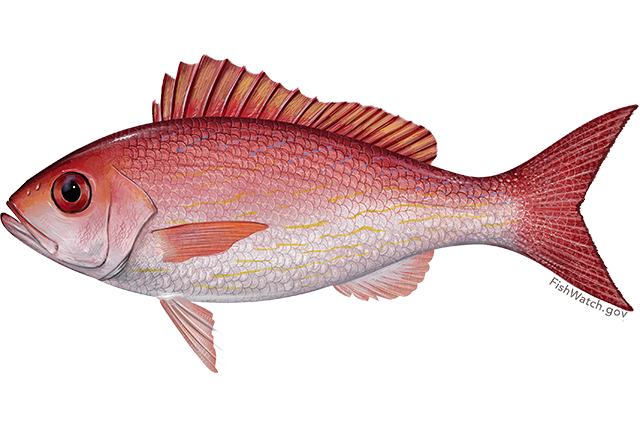Vermilion Snapper
 U.S. wild-caught vermilion snapper is a smart seafood choice because it is sustainably managed and responsibly harvested under U.S. regulations.
U.S. wild-caught vermilion snapper is a smart seafood choice because it is sustainably managed and responsibly harvested under U.S. regulations.
Appearance
- Vermilion snapper have streamlined bodies.
- They are pale to silvery white below and vermilion (orange-red) above. They have narrow, yellow-gold streaks (some horizontal and others diagonal) below the lateral line.
- Their back (dorsal) fin is rose-colored with a yellow edge, and the tail (caudal) fin is red with a faint black edge.
Biology
- Vermilion snapper grow slowly, up to 2 feet long and 7 pounds.
- They can live to at least 15 years.
- Vermilion snapper are able to reproduce when they’re young, between 1 and 2 years old.
- They spawn multiple times from April to September, but most often from June to August.
- Vermilion snapper eat fish, shrimp, crabs, worms, and other bottom-dwelling invertebrates, as well as squids and plankton (tiny floating plants and animals).
Where They Live
Vermilion snapper are found in the Atlantic Ocean from Cape Hatteras, North Carolina, to southeastern Brazil, including the West Indies, Gulf of Mexico, and Caribbean Sea.
Management
- NOAA Fisheries, the South Atlantic, Gulf of Mexico, and Caribbean Fishery Management Councils, and the governments of Puerto Rico and the U.S. Virgin Islands, manage the vermilion snapper fishery.
- In the South Atlantic, managed under the Snapper-Grouper Fishery Management Plan:
- Commercial fishermen must have a permit to harvest vermilion snapper.
- The number of available permits is limited to control fishing pressure on vermilion snapper.
- Annual catch limits divided between the commercial and recreational sectors.
- The commercial quota is divided into two 6-month fishing seasons.
- Seasons can close early if quotas are reached.
- Trip limits for commercial vessels.
- Minimum size limit to allow fish time to mature and spawn.
- Areas closed to fishing to protect a portion of the vermillion snapper population and their habitat.
- Gear restrictions prohibit the use of trawls, traps, and longlines (in some areas) to reduce bycatch.
- In the Gulf of Mexico, managed under the Fishery Management Plan for the Reef Fish Resources of the Gulf of Mexico:
- Commercial fishermen must have a permit to harvest vermilion snapper.
- Annual catch limit combined for the commercial and recreational fishery.
- Seasons can close early if the catch limit is projected to be reached.
- Minimum size limit to allow fish time to mature and spawn.
- Gear requirements and restrictions to reduce bycatch.
- Areas closed to fishing to protect sensitive fish populations and habitats.
- In the U.S. Caribbean, managed under the Fishery Management Plan for the Reef Fish Fishery of Puerto Rico and the U.S. Virgin Islands, and territorial regulations in each of Puerto Rico and the U.S. Virgin Islands:
- Managed as part of a complex with several other snapper species; this group is referred to as Caribbean snappers.
- Annual catch limits for Caribbean snappers are in place to prevent overfishing, and are allocated among the three island management areas (Puerto Rico, St. Croix, and St. Thomas/St. John).
- Fishing with pots, traps, bottom longlines, gillnets, or trammel nets is prohibited year-round in certain areas to reduce fishing impacts.
- Seasonal fishing closure to protect vermilion snapper during spawning.

